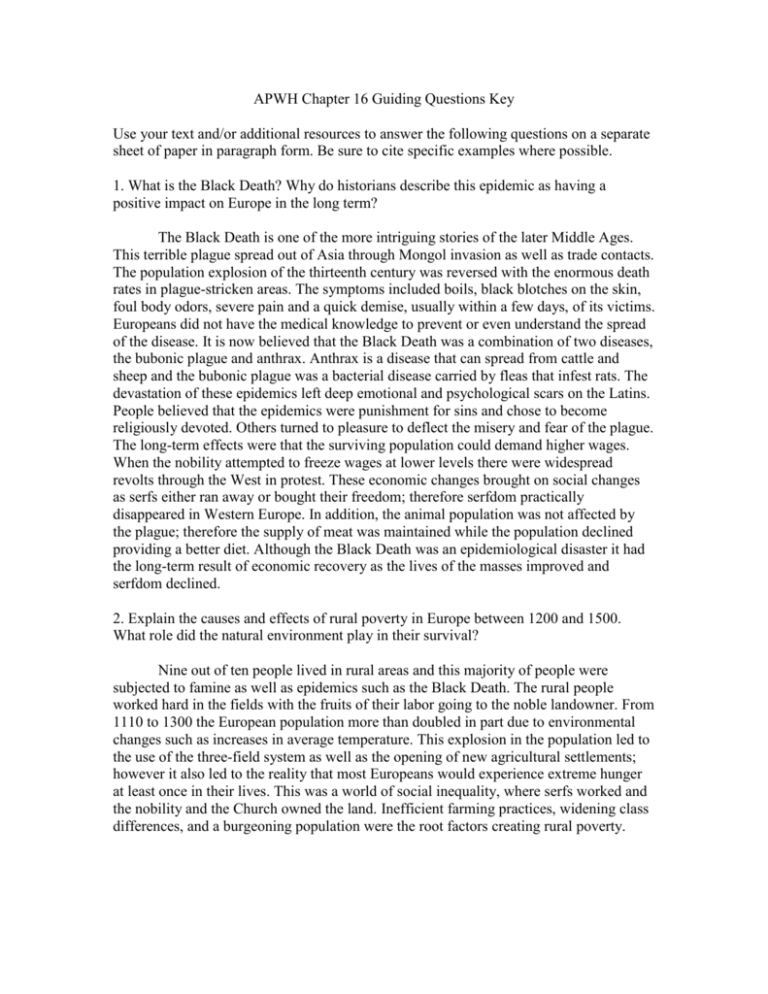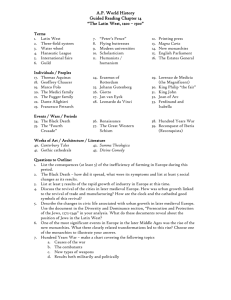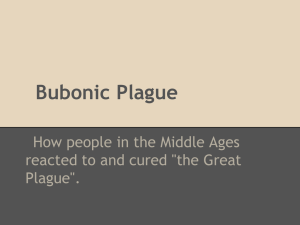APWH Chapter 16 Guiding Questions
advertisement

APWH Chapter 16 Guiding Questions Key Use your text and/or additional resources to answer the following questions on a separate sheet of paper in paragraph form. Be sure to cite specific examples where possible. 1. What is the Black Death? Why do historians describe this epidemic as having a positive impact on Europe in the long term? The Black Death is one of the more intriguing stories of the later Middle Ages. This terrible plague spread out of Asia through Mongol invasion as well as trade contacts. The population explosion of the thirteenth century was reversed with the enormous death rates in plague-stricken areas. The symptoms included boils, black blotches on the skin, foul body odors, severe pain and a quick demise, usually within a few days, of its victims. Europeans did not have the medical knowledge to prevent or even understand the spread of the disease. It is now believed that the Black Death was a combination of two diseases, the bubonic plague and anthrax. Anthrax is a disease that can spread from cattle and sheep and the bubonic plague was a bacterial disease carried by fleas that infest rats. The devastation of these epidemics left deep emotional and psychological scars on the Latins. People believed that the epidemics were punishment for sins and chose to become religiously devoted. Others turned to pleasure to deflect the misery and fear of the plague. The long-term effects were that the surviving population could demand higher wages. When the nobility attempted to freeze wages at lower levels there were widespread revolts through the West in protest. These economic changes brought on social changes as serfs either ran away or bought their freedom; therefore serfdom practically disappeared in Western Europe. In addition, the animal population was not affected by the plague; therefore the supply of meat was maintained while the population declined providing a better diet. Although the Black Death was an epidemiological disaster it had the long-term result of economic recovery as the lives of the masses improved and serfdom declined. 2. Explain the causes and effects of rural poverty in Europe between 1200 and 1500. What role did the natural environment play in their survival? Nine out of ten people lived in rural areas and this majority of people were subjected to famine as well as epidemics such as the Black Death. The rural people worked hard in the fields with the fruits of their labor going to the noble landowner. From 1110 to 1300 the European population more than doubled in part due to environmental changes such as increases in average temperature. This explosion in the population led to the use of the three-field system as well as the opening of new agricultural settlements; however it also led to the reality that most Europeans would experience extreme hunger at least once in their lives. This was a world of social inequality, where serfs worked and the nobility and the Church owned the land. Inefficient farming practices, widening class differences, and a burgeoning population were the root factors creating rural poverty. 3. What were some of the technological advances and innovations in medieval Europe that some historians refer to as an “industrial revolution?” What were the environmental consequences? The chapter states that calling this development an “industrial revolution” is a bit overstated; however, there was the growth of a number of new machines to make products and perform useful tasks. One indicator of an industrial transformation was the profusion of mills powered by both wind and water. Waterpower made possible the rapid expansion of iron making, including trip hammers, stamping mills, and bellows to shape and pour iron for a variety of new uses. Mills also processed other products such as paper, in addition to crushing olives, tanning leather, grinding grains, and sawing logs. Students should remark on the consequences of industrial growth as well. The European landscape was changed significantly by this growth. The flow of rivers was changed by dams and canals, quarry pits and mines scarred the countryside, and dumping in the streams created polluted environments. Deforestation for building and fuel was a common problem as well. In response to these environmental problems, the first antipollution law was passed in England in 1388. 4. Discuss the revival of the cities in later medieval Europe. How was urban growth linked to the revival of trade and manufacturing? How are the clock and the cathedral good symbols of this revival? Despite the fact that European cities were smaller than their Byzantine and Islamic counterparts, they were nevertheless experiencing commercial, cultural, and administrative changes. The Latin West’s “urban revival,” evident through the appearance of churches, guild halls, and residences, is due to the renewed commercial contacts with the East. The resurgence of textile and paper manufacturing combined with the growth of political unity in Europe to open new markets and trade routes. This led to a growing middle, or merchant, class, and to larger and more numerous trading centers, such as Florence, Genoa, and Venice. The clock is a potent symbol of this process because it represents both the European absorption with Eastern technology as well as civic wealth. The clock, developed originally in Song China, became an important symbol of European prosperity and fascination with technology. Clocks first appeared in Europe around 1300 and became a part of the urban landscape through their inclusion on towers and church steeples. The cathedral is an equally important way of seeing urban growth in “concrete” terms. The Gothic cathedrals of Latin cities were architectural wonders with distinctive features such as the pointed Gothic arch, flying buttresses, and stained glass windows. These magnificent spaces were the centerpieces of Latin cities and were an important symbol of their prosperity, ingenuity, and religious devotion. 5. The later Middle Ages was a period of great intellectual and artistic achievement marked by what is often called the Renaissance. What is the Renaissance and what were some of its most important and lasting cultural and artistic achievements? The Renaissance is not a break with the Medieval world but a culmination of centuries of cultural and intellectual enrichment. As the Latin cities grew, the pace of intellectual life quickened. The Byzantine and Muslim worlds were responsible for transmitting new knowledge to Europe through the preservation of Greek and Roman texts of antiquity and the knowledge they had developed themselves. The works of Plato and Aristotle as well as Arabic works were influential. In addition, the growth of European universities, which may have been modeled on the Muslim madrasas, became institutions of advanced teaching and research. This period’s major intellectual developments included Dante Alighieri’s Divine Comedy, Geoffrey Chaucer’s Canterbury Tales, and the paintings of Jan van Eyck, Leonardo DaVinci, Michelangelo, and Giotto. The financial support of wealthy merchants like the Medicis was instrumental in the cultivation of these artists. These achievements exemplify the intellectual growth of the time and have had a lasting influence on Western culture as well as the rest of the world. 6. What is humanism? What technological innovation encouraged the spread of humanist texts in Renaissance Europe? Humanism refers to an interest in the humanities; in other words, the disciplines of history, poetry, and ethics. Humanist writers such as Petrarch and Boccaccio were well known for encouraging the rebirth of classical study. Humanists were influential in reviving secondary education and revising curriculum to include classical tests. The influence of humanism was enhanced because of new printing technology. Printing originated in China, but Western Europeans improved it significantly and used printing for many purposes. Johannes Gutenberg is credited with making at least three major contributions—in the mechanical printing press, uniform cast-metal letters for movable type, and a suitable ink. The subsequent explosion of printing encouraged both the spread of literacy and the standardization of languages and was a great boon to European intellectual development. 7. Using Map 16.3 discuss how the year 1453 was important in European history and marked the changes in many national boundaries. (See pp. 412-414)









